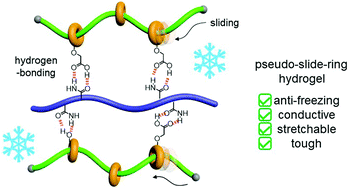Conductive and anti-freezing hydrogels constructed by pseudo-slide-ring networks†
Abstract
Stretchable, tough, and anti-freezing hydrogels were prepared using partially carboxymethylated polyrotaxanes and polyacrylamides. The carboxylic acid groups of α-cyclodextrins in the polyrotaxane and the amide groups in polyacrylamide are hydrogen-bonded, affording a pseudo-slide-ring network, greatly enhancing the hydrogels’ macroscale mechanical properties, anti-freezing features, and electrical conductivity for the fabrication of a cold-temperature strain sensor.

- This article is part of the themed collection: Host-Guest Chemistry


 Please wait while we load your content...
Please wait while we load your content...